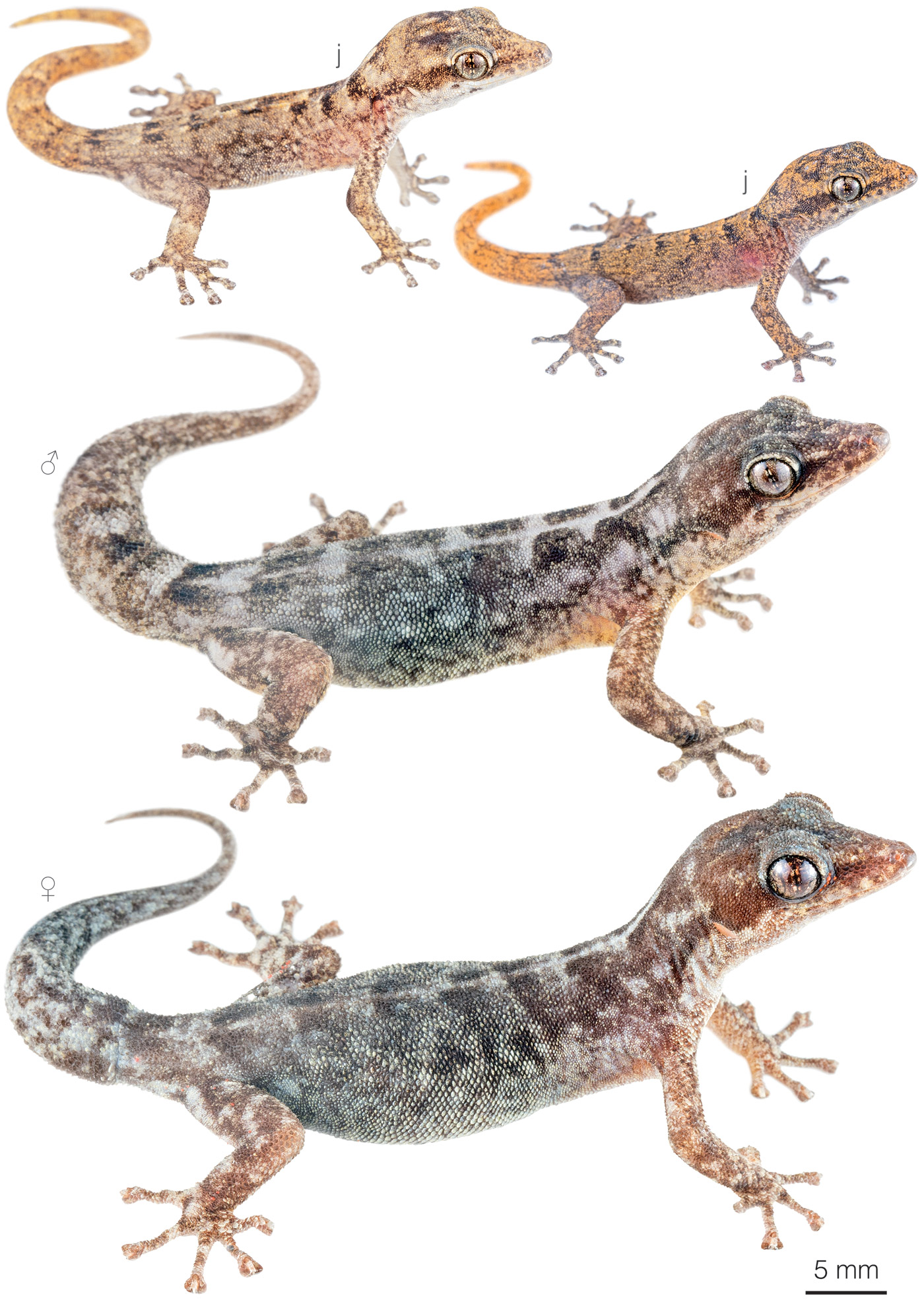Published October 10, 2019. Updated December 24, 2023. Open access. Peer-reviewed. | Purchase book ❯ |
Wolf Leaf-toed Gecko (Phyllodactylus gilberti)
Reptiles of Ecuador | Sauria | Phyllodactylidae | Phyllodactylus gilberti
English common names: Wolf Leaf-toed Gecko, Gilbert’s Leaf-toed Gecko.
Spanish common names: Geco de Wolf, salamanquesa de Wolf.
Recognition: ♂♂ 10.9 cmMaximum distance from the snout to the tip of the tail. ♀♀ 11.5 cmMaximum distance from the snout to the tip of the tail..1 Geckos in general are easily distinguishable from other lizards by their nocturnal habits and vertical pupils. Phyllodactylus gilberti is the only gecko occurring on Darwin and Wolf, the northernmost islands of Galápagos Archipelago. This species is easily distinguishable from the only other native co-occurring saurian (that is, Amblyrhynchus cristatus) by its small size and fingertips lacking visible claws.1 Adults of the Wolf Leaf-toed Gecko have a pale grayish coloration with irregular faint dark blotches and a dark postocular band. In juveniles, the dorsal background coloration is pale orangish brown (Fig. 1).1

Figure 1: Individuals of Phyllodactylus gilberti from Wolf Island, Galápagos, Ecuador.
Natural history: Phyllodactylus gilberti is a nocturnal and terrestrial gecko that occurs in comparatively high densities in the dry shrubland and semideciduous forests of Darwin and Wolf islands.1 The species seems to be more abundant along the edge of cliffs where seabirds nest, presumably to feed on flies attracted by the guano.2 During daytime, Wolf Leaf-toed Geckos seek refuge under lava blocks or in crevices,1,2 the same microhabitats to which they retreat when disturbed. There are recorded instances of predation on members of this species by owls and egrets.1,3 Individuals having regenerated tail portions are not uncommon, suggesting intense predation attempts.
Conservation: Vulnerable Considered to be facing a high risk of extinction in the mid-term future..1 Phyllodactylus gilberti is listed in this category because the species is restricted to two islands having an area less than 3 km2 each. Therefore, the entire population is prone to be affected by random unpredictable events (like droughts and introduced species) within a short time period. Although the extent of occurrence of P. gilberti is extremely small and the sole dimension of the islets implies a potential vulnerability to stochastic events, the probability of such occurrences resulting in extinction remains uncertain.4
Distribution: Phyllodactylus gilberti is endemic to Darwin (2.33 km2) and Wolf (2.85 km2), which are the most remote islands in the Galápagos Archipelago (Fig. 2). Both are the remains of a massive extinct volcano which is now submerged. On Wolf Island, the species is so far only known from the plateau.

Figure 2: Distribution of Phyllodactylus gilberti in Galápagos. The star corresponds to the type locality: Wolf Island.
Etymology: The generic name Phyllodactylus comes from the Greek words phyllon (=leaf) and daktylos (=finger),5 and refers to the leaf-shaped fingers characteristic of this group of geckos. The specific epithet gilberti honors Charles H. Gilbert (1859–1928), an U.S. ichthyologist, conservationist, and one of the founding faculty of Stanford University. Gilbert’s work included studies on the life histories of various fish species, taxonomy, and the ecology of marine organisms. He participated in several scientific expeditions, including the Harriman Alaska Expedition in 1899.6
See it in the wild: There is no terrestrial tourism allowed on Darwin and Wolf islands. Researchers and members of the Galápagos National Park may visit the habitat of Phyllodactylus gilberti, but only in the context of a scientific expedition or a conservation agenda.
Authors: Alejandro ArteagaaAffiliation: Fundación Khamai, Reserva Arlequín, Ecoruta Paseo del Quinde km 56, Santa Rosa de Mindo, Pichincha 171202, Ecuador. and Juan M GuayasaminbAffiliation: Universidad San Francisco de Quito, Quito, Ecuador.
Academic reviewer: Cruz MárquezcAffiliation: University of Rome Tor Vergata, Rome, Italy.
Photographer: Lucas BustamantedAffiliation: Tropical Herping (TH), Quito, Ecuador.
How to cite? Arteaga A, Guayasamin JM (2023) Wolf Leaf-toed Gecko (Phyllodactylus gilberti). In: Arteaga A, Bustamante L, Vieira J (Eds) Reptiles of Ecuador: Life in the middle of the world. Available from: www.reptilesofecuador.com. DOI: 10.47051/CLCZ3276
Literature cited:
- Arteaga A, Bustamante L, Vieira J, Tapia W, Guayasamin JM (2019) Reptiles of the Galápagos: life on the Enchanted Islands. Tropical Herping, Quito, 208 pp. DOI: 10.47051/AQJU7348
- Van Denburgh J (1912) Expedition of the California Academy of Sciences to the Galápagos Islands, 1905-1906. VI. The geckos of the Galápagos Archipelago. Proceedings of the California Academy of Sciences 1: 405–430.
- Koster F, Koster H (1983) Twelve days among the “vampire finches” of Wolf Island. Noticias de Galápagos 38: 4–10.
- Márquez C (2017) Phyllodactylus gilberti. The IUCN Red List of threatened species. Available from: www.iucnredlist.org. DOI: 10.2305/IUCN.UK.2017-2.RLTS.T48443661A48443666.en
- Brown RW (1956) Composition of scientific words. Smithsonian Books, Washington, 882 pp.
- Heller E (1903) Papers from the Hopkins Stanford Galápagos expedition, 1898-1899. XIV Reptiles. Proceedings of the Washington Academy of Science 5: 39-38.